August 4 - 31, 2024: Issue 633
bungaree descendant laurie Bimson places family boomerang with reinterred captain flinders
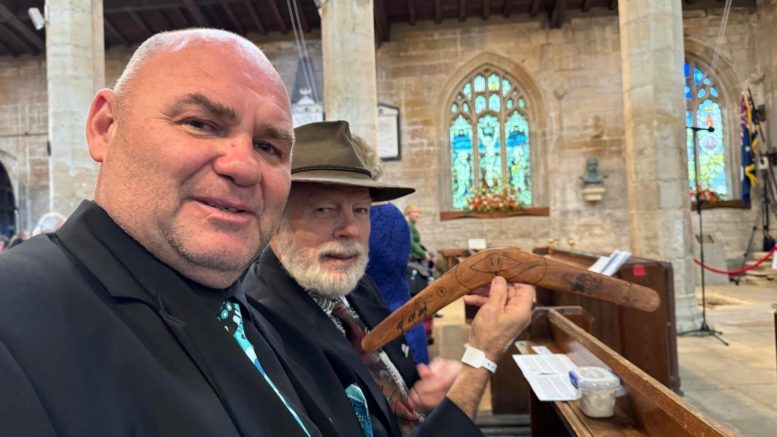
The renowned explorer who named local man Bungaree ‘The First Australian’ was reburied in his birth village on Saturday, July 13 2024. The remains of Captain Matthew Flinders, the explorer who famously circumnavigated Australia with local Aboriginal man Bungaree, was re-interred in his birthplace of Donington, Lincolnshire.
The village, located about 185km north of London, saw thousands lining its streets to honour the explorer. Among the attendees were descendants of Bungaree, Shad Tyler from the Central Coast and Uncle Laurie Bimson, a great-great-great grandson of Bungaree and from our area, who lives On Country still.
The remains of Flinders, lost in the mid-1800s, were rediscovered in 2019 during the HS2 high-speed rail excavations in London.
See: Remains Of Captain Matthew Flinders Discovered At HS2 Site In Euston
Soon after a UK based Group, 'Matthew Flinders Bring Him Home', was established in Donington to collaborate with all and do whatever they can to try to ensure that Matthew was returned to Donington as his future resting place. Jane Pearson, who worked for years to bring Flinders home, said about 80 people from Australia were among 400 guests at the ceremony, when Flinders was reburied under the floor of St Mary and the Holy Rood in Donington.
Royal Navy sailors and officers marched through Donington, accompanying the casket, covered with both the Union Jack and Australian flag. to the local church, where the ceremony took place. Captain Flinders' remains were laid to rest in an event marked by deep emotions and historical reverence.
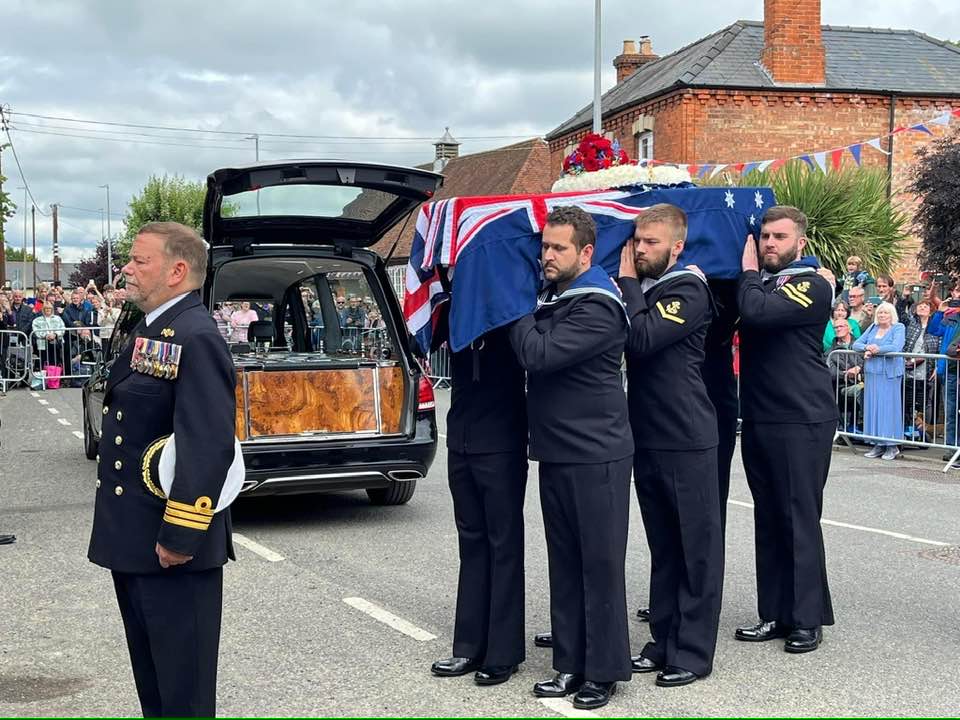
Photo: Stephanie Goodacre/'Matthew Flinders Bring Him Home' Group
Mr. Tyler and Mr. Bimson travelled to London after being invited to attend the ceremony as representatives of the descendants of Bungaree, who became a close friend and confidant of the English explorer.
Captain Matthew Flinders’ appreciation for Bungaree’s navigational assistance and diplomatic work with other Aboriginal tribes was so great he noted in his diaries he considered Bungaree ‘The First Australian’.
Bungaree first went to sea aboard HMS Reliance on May 29, 1798, sailing from Sydney Cove to Norfolk Island. His indigenous shipmates were Nanbarry, a Cadigal, and Wingal from Port Stephens. It was during this 60‐day round voyage that Flinders first met and came to respect Bungaree.
In 1799 Flinders took Bungaree with him on a survey voyage to Bribie Island and Hervey Bay on the 25‐tonne decked longboat, Norfolk. Flinders relied on Bungaree's knowledge of Aboriginal protocol and his skill as a go‐between with local Aborigines during this six‐week voyage.
During 1802‐03 he became the first Australian to circumnavigate the continent 36,000 kilometres of coastline when he sailed with Captain Matthew Flinders in the sloop HMS Investigator which also visited Timor. On this long voyage Bungaree used his knowledge of Aboriginal protocol to negotiate peaceful meetings with local Indigenous people.
Years later, in A Voyage to Terra Australis (1814), Flinders wrote that Bungaree's; "good disposition and open and manly conduct had attracted my esteem".
Flinders described the affectionate relationship between Bungaree and the cat Trim who sailed on Flinder’s ships: ‘If he [Trim] had occasion to drink, he mewed to Bongaree and leapt up onto the water cask; if to eat he called him down below and went straight to his kid, where there was generally a remnant of a black swan. In short, Bongaree was his great resource, and his kindness was repaid with caresses.’
Pittwater Online News spoke to Uncle Laurie, who runs Guringai Aboriginal Tours, on his return from the U.K., about how his involvement with this project began and his experiences in 'Old Blighty'.
''I became involved when Ruth Taylor, author of 'The Cat and the Captain: Trim the Cat & Matthew Flinders' (published 2020) contacted me. Ruth wanted to meet relatives of Bungaree and talk to them.'' Laurie explained
''Ruth was born by the sea in Bournemouth, Dorset, setting a trend of attachment to oceans for the rest of her life. At the age of two she became a Ten Pound POM – sailing to Australia with her family on the Assisted Passage Scheme. Matthew Flinders was a familiar historical figure to her while she was living in Melbourne, where she trained as a nurse. Ruth returned to the UK and after studying medicine at Sheffield University she qualified as a doctor in 1978, and as an obstetrician and gynaecologist in 1983. Ruth then retrained as a GP, working on cruise ships in her holidays until 2015. While researching the role of cats on ships in the UK National Maritime Museum, she came across the story of Captain Flinders and Trim and decided that their story had to be told for children. Ruth currently lives in London with her husband.''
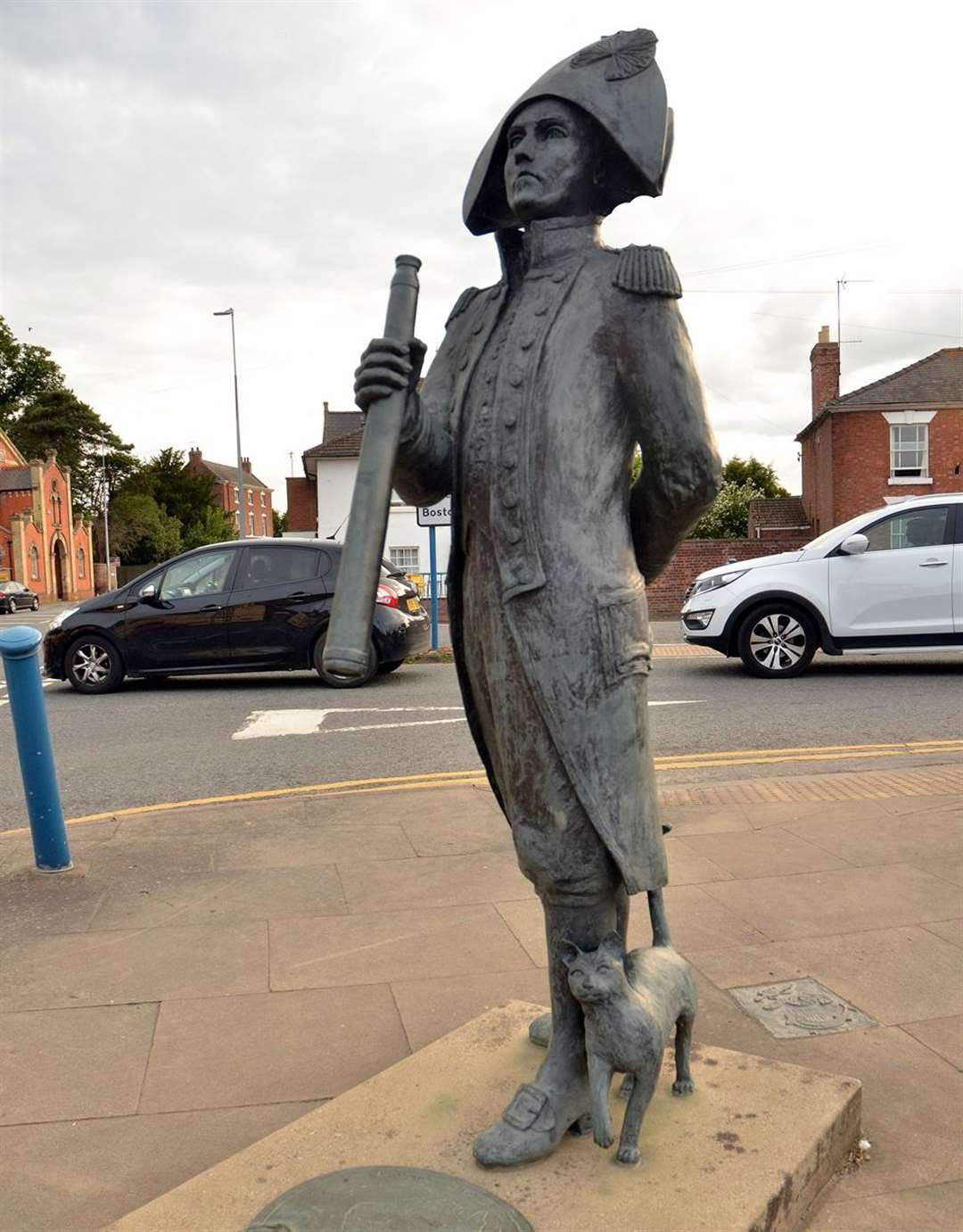
Statue of Matthew Flinders (and Trim) at Donington. Photo courtesy: Matthew Flinders Bring Him Home group
Laurie is an Aboriginal man from what is known as Guringai country. The name 'Guringai' was coined by ethnographer John Fraser in 1892 as the original name of the tribal group was not known. The word for man or person is kuri (Koori) and kuringga, the possessive means ‘belonging to kuri’. Ngai (ng/guy) means woman.
''There are many clans in Guringai country, Garigal being one of them which is our clan.'' Laurie says
''My people are salt water people and have been the custodians of Guringai country for about 40,000 years. Guringai country covers a large area to the north of Sydney Harbour up to Lake Macquarie and from the Pacific Ocean out to Wisemans Ferry. We look after this land and in turn the land looks after us.''
''When I was young my dad taught me to survive. He showed me how to make spears and boomerangs and humpy’s. He also showed me how to catch yabbies, eels and fish and what plants to eat. We were the only kids in the street with a humpy outside our back fence. We used to go down to the local aboriginal carvings all the time. We were Aboriginal and I was very proud. I was always envious of my Aboriginal friends dark skin – I wished mine was darker. I was always in the bush (it drove my mum crazy!). She always asked “What did you survive on? You have been gone all weekend!” I had the best cave that I used to stay in.''
Laurie and Shad were Guests of Honour at the service for Captain Flinders at Donington.
''We were in the second row of the church,'' Laurie said, '' among Governor Generals and other VIP's. We were going to sit further back but Lord Rose said 'no, no, you two need to sit here, among Captain Flinders relatives - you're an important part of this.'.
''My son Tom had made a boomerang for the service and Captain Flinders, marked with the Stingray, our family's totem, from our clan. You can also see three emus (coastal) and mob sitting around a camp fire....signed with language. The ochre symbolises connection to country to make you see and feel more, when you are there.
Once they had lowered Captain Flinder's casket I covered the boomerang for Flinders with ochre from a Scared Ochre Site on the northern beaches, and put this in the grave with him and his casket.''
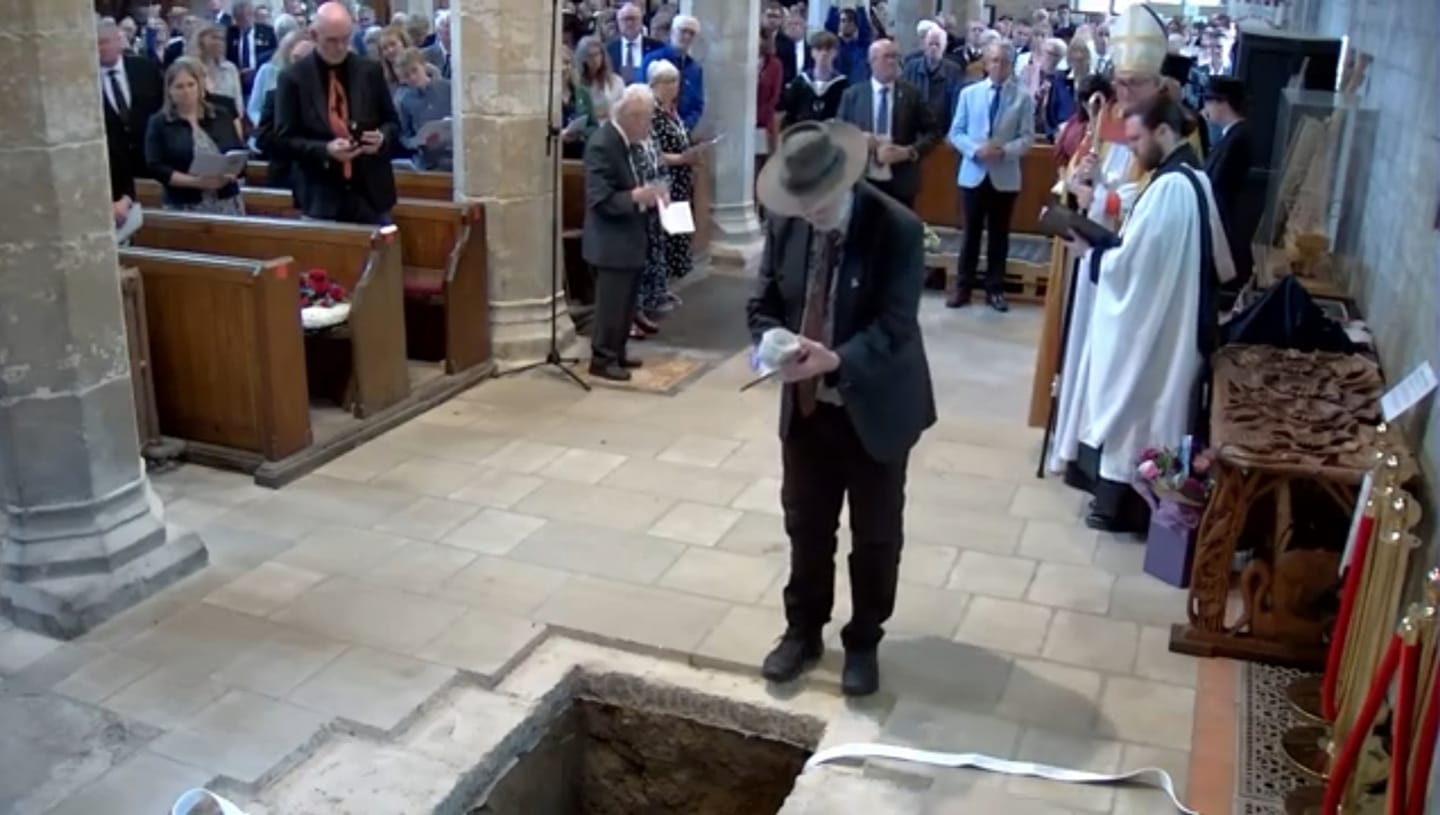
screenshot from a film of the ceremony, Laurie, a descendant of Bungaree, honouring his GGG Grandfather and family connection to Captain Flinders.
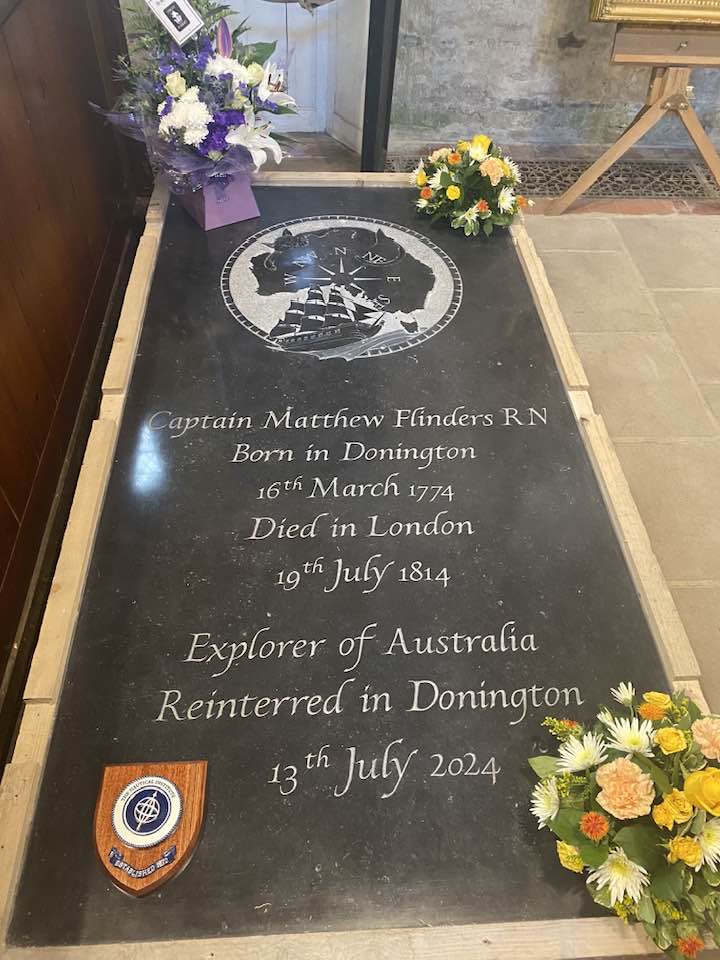
Flinders' ledger stone now in place. Note the map of Australia and Trim the cat at top. Photo: Matthew Flinders Bring Him Home group
Australia’s Assistant Navy Attaché, Commander John Relyea, represented the ADF at the service.
“It was an emotional one, understanding the incredible impact that Captain Flinders has had on Australia and the world. He was a pioneer whose charting skills were so accurate they are being used some two centuries later,” Commander Relyea said.
Also in attendance at the service were the South Australian Governor Frances Adamson and Australia’s Deputy High Commissioner, Elizabeth Bowes.
After the service Laurie and Shad were interviewed by Australian and United Kingdom television and newspaper press and then met and spent time with more of Captain Flinders relatives and those who call the village of Donington home, all of whom turned out and decorated the village with flags and bunting.
A full military and gun salute, with Australian and British flags adorning local gardens and businesses, formed part of the three day ceremony.
''It was awesome,'' Laurie said, ''The whole village turned out to honour their returning son.''
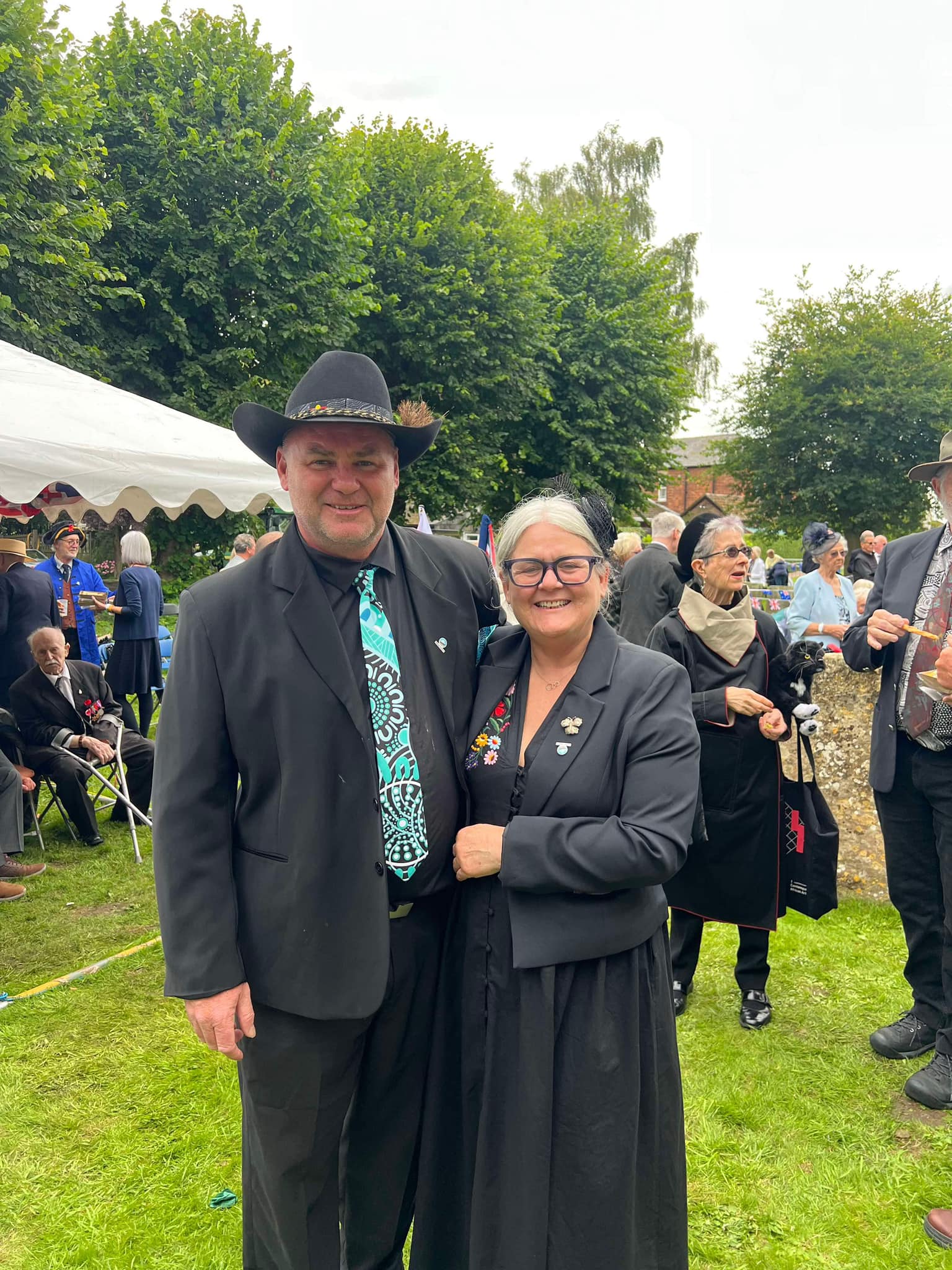
Julie Flinders; ''Such a pleasure to meet Shad''. Ruth Taylor is in the background, talking to Laurie.
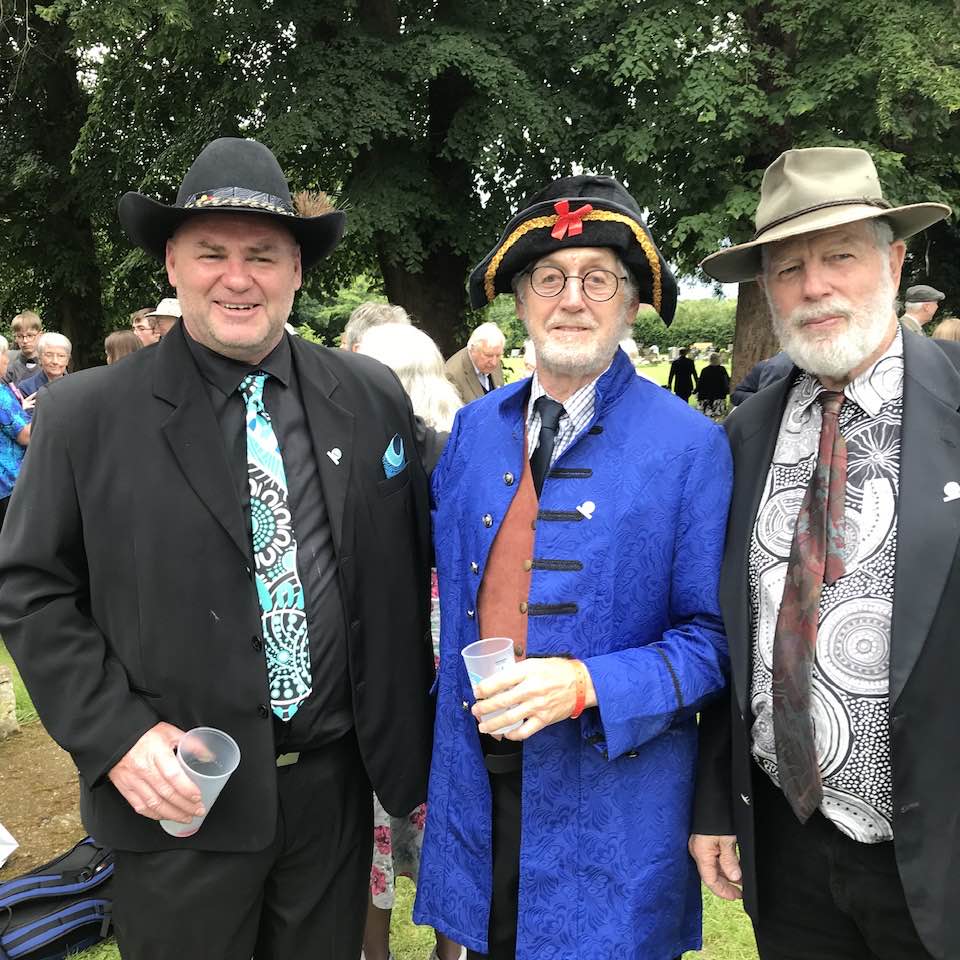
Ian Flinders with Shad and Laurie. Photo: Stephanie Goodacre/ 'Matthew Flinders Bring Him Home' group
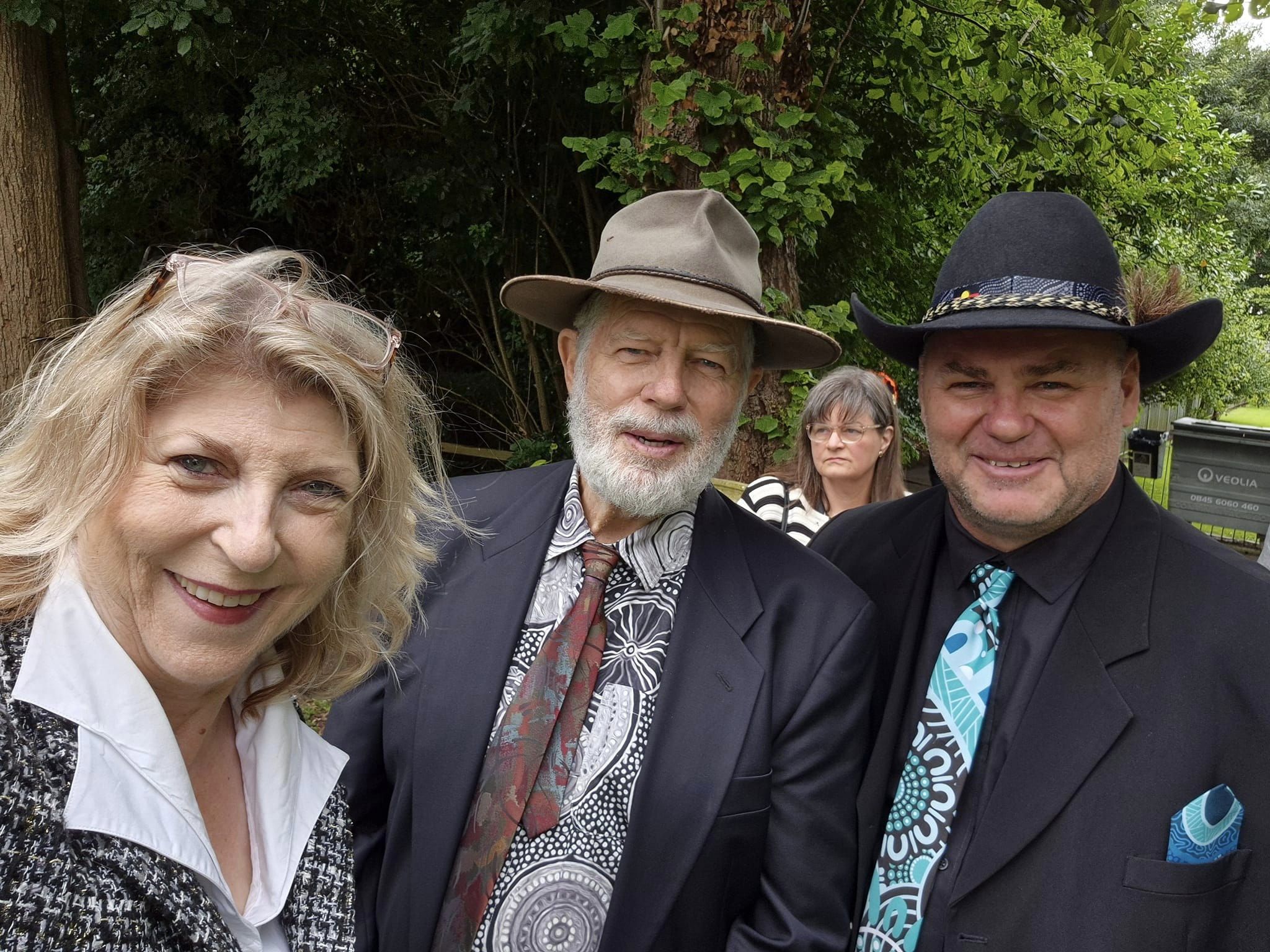
Diana Mislov - Mayor, City of Port Lincoln; ''It was such a privilege to represent the City of Port Lincoln Council, South Australia, at the reburial of Capt. Matthew Flinders.''
.jpg?timestamp=1722542031826)
Flinders descendants with Bungaree descendants Shad and Laurie. Photo: Stephanie Goodacre/ 'Matthew Flinders Bring Him Home' group
Mr. Tyler and Laurie also visited Pitt Rivers Museum to view one of Bungaree’s clubs in its collection. The club is said to have been given by Bungaree to ‘Mr Smith an assigned servant to Mr Kenyon of Smithfield’. [1.]
Laurie said the story, according to Bungaree family lore, is that Bungaree said, ''It's got a crack in it, but I suppose you can have it...''
The club was donated to the Pitt Rivers Museum in 1900 by an R F Wilkins as part of the Norman Hardy Collection. Norman Hardy appears to have obtained much of his collection from Harry Stockdale, an artist, explorer and pioneer ethnologist who made many drawings of Aboriginal weapons, utensils and decorations. Some of these are with Stockdale’s unpublished essays on Aboriginal weapons, ceremonies, mysteries and folk stories now housed in the Mitchell Library, State Library of NSW, Sydney.
Laurie said, on entering the museum, that the first thing that struck him was the presence of elders in that place.
''There were lots of spirts in that place due to all the stolen stuff they have housed there,'' he said.
''I could feel them, feel their presence, which is very strong in that place.''
The fighting club is said to have been used by Bungaree in ‘the war between the Tribes of Liverpool and those of Five-Dock in around 1813 or 1823.
Although there is no record of any ritual battle or hostilities at that time between the Sydney ‘tribes’ mentioned, it is known that ‘about 100 less natives than usual’ (normally 300) attended the annual Native Conference at Parramatta on 29 December 1823. [Sydney Gazette, 29 December 1823, page 2]
In contrast, around 400 Aborigines were at Parramatta the following year. [Voyages and travels round the world : by the Rev. Daniel Tyerman and George Bennett, Esq … between the years 1821 and 1829, London Missionary Society, 2nd ed.1841, page 178]
A similar fall-off in attendance was evident in 1826 when the Liverpool and Illawarra [South Coast of NSW] Aborigines were involved in a ‘war’ with the Cow Pastures [Camden] ‘tribe’. [Sydney Gazette 30 December 1836, page 2]
Laurie said he was very moved when seeing the club of his grandfather.
''I started crying a bit, to be honest with you,'' Laurie said.
''Then they let us touch it - they weren't allowed to touch it with anything other than gloves as it is considered a sacred object and there are protocols in place. But we, as his relatives, were allowed to.''
''Think of that, we were the first people from his clan to touch it in over 200 years.''
''While we were there we were able to share insights about the boomerang and other objects in the museum's collection with schoolchildren that were visiting for a pour while we were there.
''They (the tour guides) were getting it wrong, so it was great to provide the correct meanings and use and deepen their education and understanding of what they were looking at.'' Laurie beamed
A sculpture of Bungaree, by Aboriginal sculptor Laurie Nilson, can be seen in Mosman Town Hall.
Despite the fame and affection Bungaree was, and is held in, he is not publicly honoured in the same way as white men from the same period, in part due to respecting First Nations traditions that prohibit the referring to a dead person by name directly after their death as a mark of respect, and to not cause pain to family members. This extends to images of people who have passed as well.
However, Bungaree is one of our most famous local original Broken Bay and Pittwater Custodians of Country, with numerous sketches and paintings of him by colonial artists having been made while he lived here. His nose, as just one example, can still be seen as a prominent feature in his descendants' faces - as can his broad smile.
His notable absence from Macquarie Street’s parade of statues remains a point of contention and conversation for some though. There have been calls for years for some nod towards Broken Bay peoples to be placed at Governor Phillip Park, where one of Bungarees' sons, Bowen, lived when part of the Broken Bay Customs Station camp at the northern end of Station Beach.
One signboard was dedicated outside Mona Vale Library in 2018, but none have been placed in Pittwater since.
Central Coast Bungaree descendant and GuriNgai woman Tracey Howie, said, “Bungaree was a very important figure in that time; his work with Flinders is a testament to his importance,”
The Central Coast is home to the GuriNgai, Darkinoong and Awabakal nations and part of their Traditional Country, although no sign anywhere would you allow you to know that.
“Even up on the Central Coast, in Bungaree’s traditional country, we have a really high ridge line there called Rumbalara. On that hill is another statue of Flinders and not of Bungaree,” Tracey told the Guardian.
“The cat [is remembered] but no statue of the person who looked after them is here.”
For many the Flinders and his cat statues prominence and the absence of his companion is particularly galling, given Bungaree’s important role during the mapping of Australia.
The obverse of this is it is worth considering that perhaps a colonial-style statue alongside Flinders is not the best way to honour Bungaree. Being permanently associated with Flinders, as part of his honorary tableau, does little to honour Bungaree’s life. It may even, from some points of view, reinforce the idea that his accomplishments were merely extensions of colonial glory, when really they were a reflection of a kindly people and wise clan of this place.
Laurie refers everyone back to his work to Welcome everyone to Country in the walks he guides them through in his great-great-great grandfathers' place.
''When I can take them through this place, and encourage them to just be in this place and listen quietly, they can hear the old songs, and feel the presence in this place, still.”
And that goes back to the lore of Bungaree and the stingray totem.
Stingrays symbolise knowledge of the law/lore beneath the top surface of the earth. In the Aboriginal traditional knowledge this is a fundamental truth and law that no-one can deny. The children and grandchildren of those with the stingray as their totem mean that they were and are significant leaders who have strong power and knowledge of their country. For these peoples, like the stingray, know of its deep qualities and what is beneath the surface of the land - the songs and songlines - that manifest as physical country we all live within and how to approach and live in those places and with those peoples with respect, with understanding, with Caring for Country.
Just as Bungaree did when circumnavigating Australia with Captain Flinders.
Laurie's family gift to Captain Flinders reinforces, extends and honours that historic connection and current tradition, bringing alive and keeping the flame alight of this spirit in and of the Broken Bay peoples, from a descendent of one of those peoples themselves.
Or as fellow Aboriginal Support Group Manly Warringah Pittwater member Neil Evers, Laurie's cousin and another descendant of Bungaree states during Welcome to Country insights at local events:
Barley Ki Giballee Yaddung Guringai Wannangini
Which in English is;
You and me come together today as one in Guringai country.
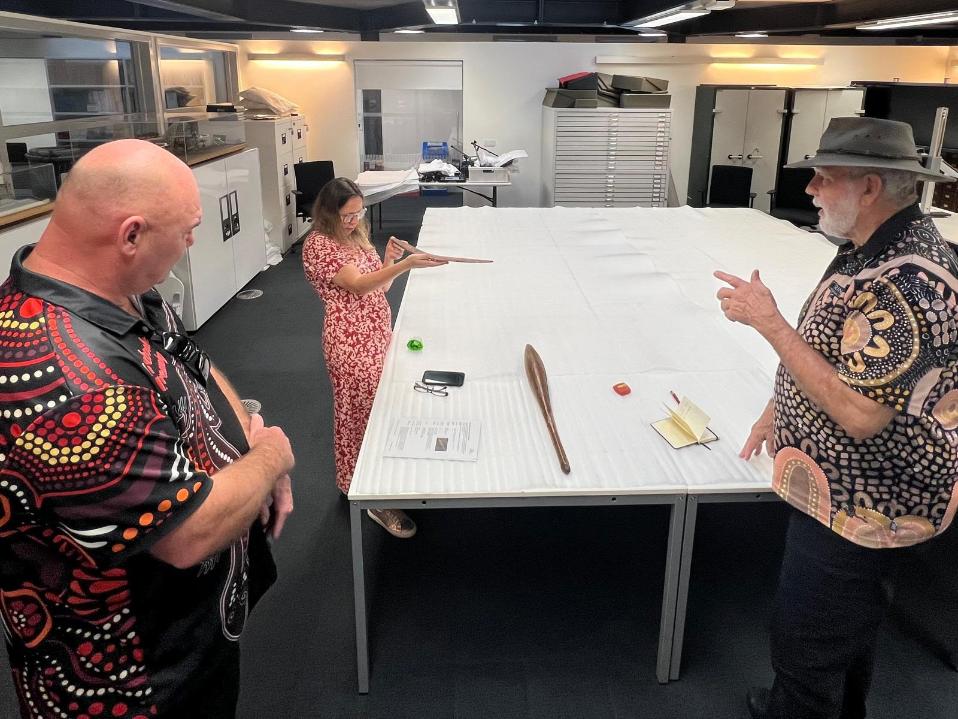
Sculthorpe, G., & Simpson, D. (2023). Will my boomerang come back? New insights into Aboriginal material culture of early Sydney and affiliated coastal zone from British collections. Australian Archaeology, 89(2), 149–171. Available online at: https://doi.org/10.1080/03122417.2023.2214336